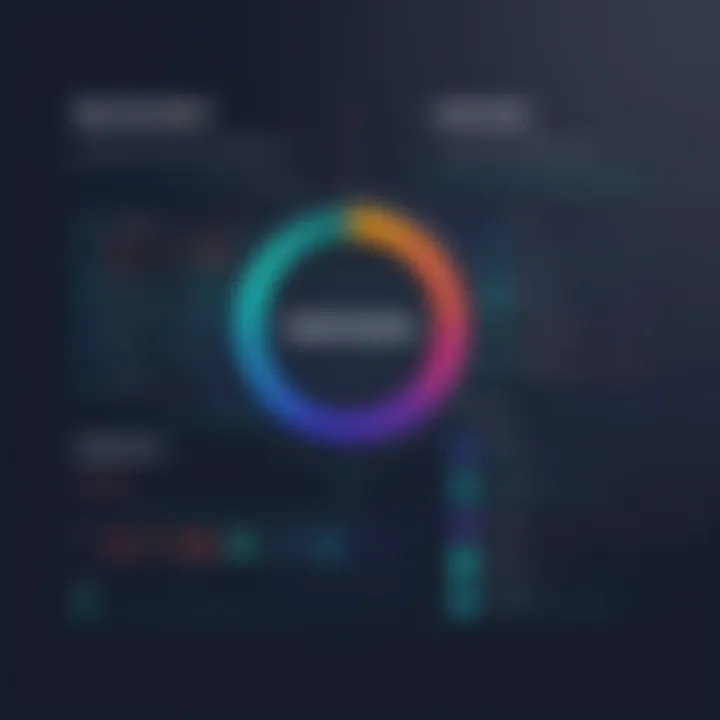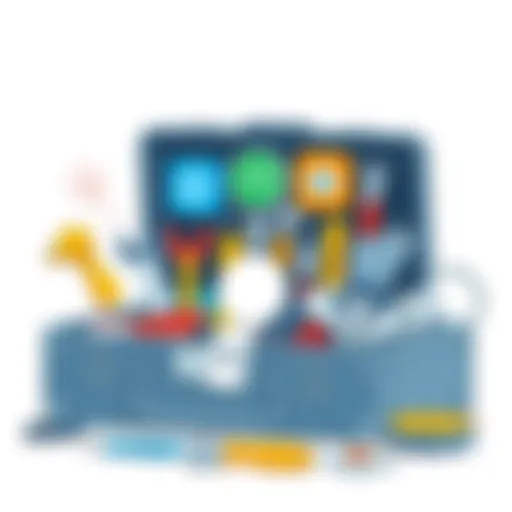Optimizing Employee Engagement with Betterworks Engage


Intro
In today's competitive workplace, engaging employees is vital to organizational success. Employee engagement directly influences productivity, morale, and retention rates. Betterworks Engage emerges as a strategic tool designed to foster this engagement. By implementing comprehensive frameworks and innovative features, Betterworks Engage can transform how organizations interact with their workforce. Understanding its components is essential for decision-makers looking to enhance engagement strategies.
Software Overview
Brief Description of Software
Betterworks Engage is a robust employee engagement platform aimed at helping organizations track, monitor, and enhance employee engagement levels. It integrates seamlessly into existing workflows, providing real-time feedback mechanisms and data analytics that inform leadership decisions. Designed with usability in mind, it allows companies to effectively communicate with their teams, ensuring alignment with organizational goals.
Key Features and Functionalities
- Real-Time Feedback: Employees can share their thoughts and feelings about their work environment, allowing management to respond promptly.
- Goal Alignment: The software facilitates setting individual and team goals, ensuring they align with organizational objectives.
- Pulse Surveys: Regularly scheduled surveys help gauge employee sentiment, identifying areas needing attention.
- Performance Analytics: It provides insights into engagement trends, enabling data-driven decision making to enhance engagement strategies.
- Integration Capabilities: Betterworks Engage easily integrates with HR systems, streamlining the data collection process.
Detailed Comparison
Comparison with Competitors
In the realm of employee engagement tools, Betterworks Engage faces competition from platforms like 15Five, TINYpulse, and Culture Amp. Each provides unique features tailored to organizational needs, yet Betterworks Engage stands out for its focus on real-time feedback and extensive goal-setting capabilities. These elements foster a more dynamic approach to employee engagement compared to the comparatively static methods often employed by competitors.
Pricing Structure
Betterworks Engage employs a subscription-based pricing model. While specific pricing details can vary, potential customers should expect tiered packages based on organizational size and feature requirements. Businesses interested in comprehensive engagement solutions may find that the investment in Betterworks Engage yields a strong return through enhanced employee satisfaction and productivity. Understanding the pricing structure is crucial for budget-conscious decision-makers.
"Investing in employee engagement tools like Betterworks Engage can lead to increased productivity and higher retention rates."
In summary, Betterworks Engage provides an array of features designed to enhance employee engagement. By understanding its functionalities and analyzing its position in the market, decision-makers are better equipped to recommend solutions that align with their organizational objectives.
Prelims to Employee Engagement
Employee engagement has emerged as a pivotal aspect of organizational success in contemporary workplaces. As the business landscape evolves, understanding and optimizing employee engagement become crucial for several reasons. Engaged employees demonstrate higher levels of productivity, commitment, and satisfaction. These factors lead to lower turnover rates and a stronger organizational culture. Furthermore, employee engagement influences overall business performance and growth.
In this article, we will explore the nuances of employee engagement, focusing on its definition and importance in modern workplaces. Each of these elements contributes to a sustainable workplace environment where employees feel valued and motivated.
Defining Employee Engagement
Employee engagement can be defined as the emotional commitment an employee has to their organization and its goals. This commitment goes beyond mere job satisfaction; engaged employees actively contribute to their team and organization. They tend to invest discretionary effort, which can immensely benefit organizational performance.
An engaged workplace is characterized by clear communication, mutual respect, and strong relationships between employees and management. The level of engagement can be gauged through various metrics, often derived from surveys, feedback sessions, and performance assessments. Overall, defining employee engagement sets the stage for understanding its impact in the workplace.
Importance of Engagement in Modern Workplaces
In today’s competitive landscape, prioritizing employee engagement is not just an HR initiative but a strategic imperative. Here are several key reasons highlighting its importance:
- Increased Productivity: Engaged employees are more likely to go above and beyond their basic duties, leading to higher productivity levels. This increment correlates with better business outcomes.
- Improved Employee Retention: High levels of engagement contribute to employee loyalty, ultimately resulting in reduced turnover rates. Companies with engaged teams frequently report lower recruitment and training costs.
- Enhanced Innovation: An engaged workforce feels free to share ideas and contribute to problem-solving. This fosters a culture of innovation, vital for businesses looking to evolve and adapt.
- Stronger Employer Brand: Companies known for high engagement often attract top talent. A positive reputation builds a compelling employer brand, amplifying competitive advantage.
"Engaged employees are the backbone of any successful organization, driving performance and innovation."
Considering these facets, it’s clear that employee engagement is not a mere buzzword but an essential component of a thriving organization. Such insights lead us to the exploration of Betterworks Engage, a tool designed to enhance engagement and, consequently, business performance.
Overview of Betterworks Engage
Understanding Betterworks Engage is crucial for any organization aiming to enhance employee engagement. Employee engagement is not merely a trend but a strategic imperative for many companies. Betterworks Engage offers a platform specifically designed to foster this engagement in meaningful ways. Looking into its core components will reveal how it can drive both productivity and satisfaction across diverse employee demographics.
What is Betterworks Engage?
Betterworks Engage is a cloud-based platform that focuses on improving employee engagement through a systematic approach. It integrates various functions such as goal-setting, continuous feedback, and performance management all in one system. The platform serves to align organizational objectives with individual performance. It helps employees understand their roles better within the larger context of the company’s mission. Such clarity can result in a more motivated workforce that feels valued and recognized.
By providing tools that facilitate open communication and objective tracking, Betterworks Engage stands out as a robust solution in the employee engagement space. Key capabilities include:
- Goal alignment: Connecting individual goals with company goals.
- Continuous feedback: Enabling real-time performance insights and recognition.
- Performance metrics: Quantitative data to evaluate progress.
- Integration with existing tools: Seamlessly collaborating with other platforms for better functionality.
As such, it becomes a crucial component for modern organizations that want to implement a culture of engagement and accountability rather than mere performance reviews.
Key Features of Betterworks Engage
The features of Betterworks Engage contribute to its ability to elevate employee engagement significantly. Here are some of the essential elements:


- Goal Management: The platform encourages both top-down and bottom-up goal setting, allowing employees to understand how their personal targets contribute to the broader company objectives.
- Continuous Feedback: Betterworks foster a culture of continuous improvement. It enables regular feedback cycles, which can substantially enhance employee performance and morale. Employees can instantly recognize their strengths and areas for development.
- Performance Reviews: Rather than relying on annual reviews, Betterworks supports ongoing performance discussions. This leads to actionable insights and a stronger sense of purpose.
- Integration Capabilities: Betterworks can integrate with tools already in use within an organization, such as Slack, Google Workspace, and others, making adoption easier and more effective.
- Analytics Dashboard: The built-in analytics module allows managers to track engagement levels easily. It gives valuable insights into trends, such as retention rates and employee satisfaction levels.
Theoretical Foundations of Engagement Tools
Understanding the theoretical foundations of engagement tools is crucial for effectively implementing solutions like Betterworks Engage. These theories provide the underlying principles that inform strategies for fostering employee engagement. They aid in understanding why engagement matters and how specific tools can enhance it. This foundational knowledge ensures that organizations can select engagement solutions that align with their culture and workforce needs.
Understanding Engagement Theories
Engagement theories have evolved over time. They aim to explain the dynamics of employee participation and commitment on the job. Some prominent theories include Maslow's Hierarchy of Needs, Herzberg's Two-Factor Theory, and the Job Demands-Resources Model.
- Maslow's Hierarchy of Needs: This theory suggests that individuals are motivated by a series of hierarchical needs, from basic physiological needs to self-actualization. Organizations need to address employee needs at all levels to foster engagement.
- Herzberg's Two-Factor Theory: Herzberg differentiates between hygiene factors and motivators. Hygiene factors, like salary, do not contribute to long-term satisfaction, but motivators, like recognition, do. Engagement tools should focus on enhancing motivators to cultivate a more engaged workforce.
- Job Demands-Resources Model: This model posits that job resources can help reduce burnout while promoting motivation. Tools that enhance job resources are vital for improving engagement outcomes.
Understanding these theories allows leaders to select and customize tools more effectively. For example, a tool that offers personalized feedback aligns well with Herzberg's theory as it focuses on motivation. Recognizing what drives your team can lead to better outcomes.
Aligning Theory with Practice
Bridging theory and practice requires thoughtful implementation of engagement tools. Organizations should not only invest in technology like Betterworks Engage but also incorporate the theories of engagement into their usage.
- Training and Development: Ensure that leadership is trained in engagement theories. This equips them to use Betterworks Engage effectively, tailoring it to their team’s needs.
- Feedback Mechanisms: Establish clear channels for feedback. Aligning with the Job Demands-Resources Model, these channels can enhance job resources and reduce burnout.
- Recognition Programs: Create recognition initiatives based on Herzberg’s principles. Implement features in Betterworks Engage that highlight employee accomplishments and contributions.
- Evaluate and Adapt: Regularly assess how these theories are reflected in practice using KPIs. Determine what aspects are working and which need adjustment.
"A successful engagement strategy is not merely about the tools employed but understanding the principles that bind these tools to the employee experience."
By understanding and applying these theoretical foundations, organizations can optimize their employee engagement strategies. This alignment can lead to a more engaged workforce, boosting productivity, morale, and retention.
Integrating Betterworks Engage into Organizational Culture
Integrating Betterworks Engage into an organization's culture is pivotal for maximizing employee engagement. This integration not only allows for the effective use of the platform but also encourages a shift in mindset. A successful integration can lead to improved communication, increased transparency, and ultimately higher productivity. It is essential for decision-makers and IT professionals to approach this task with a comprehensive understanding of the organization’s unique dynamics.
One of the main advantages of aligning Betterworks Engage within the organizational culture is the promotion of a feedback-rich environment. Continuous feedback mechanisms empower employees to share their views and feel heard. This creates a sense of belonging and trust, essential for any organization aiming for long-term success. Additionally, the alignment fosters a culture of accountability and recognition, where employees are keen to meet their objectives because they see a clear connection between their contributions and the company’s goals.
Strategies for Effective Integration
To ensure a smooth integration of Betterworks Engage, organizations can adopt several strategies. These include:
- Leadership Commitment: Ensure that leaders are actively involved in the process. Their engagement sets a tone and encourages employees to partake in the new system.
- Training and Development: Implement comprehensive training sessions that focus on the features of Betterworks Engage. This builds confidence among employees and decreases resistance.
- Pilot Programs: Start with pilot programs in specific departments to assess the effectiveness of Betterworks Engage. Gather insights and feedback to make further adjustments before a full rollout.
- Employee Involvement: Encourage employees to share their ideas and participate in discussions about how to implement Betterworks Engage.
Integrating these strategies lays a solid foundation for Betterworks Engage to thrive within the workplace.
Overcoming Resistance to Change
Resistance to change is a common challenge when introducing new tools like Betterworks Engage. To effectively navigate this, management should acknowledge the concerns of employees. Clear communication is paramount. Explain why the integration is necessary and how it will benefit both the organization and individuals.
Some effective approaches include:
- Open Forums: Host open forums for employees to voice their concerns and ask questions. This practice creates a platform for dialogue.
- Highlighting Benefits: Regularly showcase success stories and benefits realized from the use of Betterworks Engage. Sharing data on improved engagement rates can convert skepticism to acceptance.
- Ongoing Support: Provide continuous support during the transition period. Establish a point of contact for help or questions.
By recognizing resistance and addressing it thoughtfully, organizations can pave the way for a successful assimilation of Betterworks Engage into their cultures.
Measuring Engagement Effectiveness
Measuring engagement effectiveness is a critical component in understanding how well Betterworks Engage functions within an organization. The effectiveness of employee engagement initiatives can significantly impact overall productivity, employee satisfaction, and retention rates. Therefore, businesses should prioritize measuring engagement to ensure that their efforts yield tangible results.
In assessing engagement effectiveness, organizations gain insights into the areas where they excel and where improvements are needed. Metrics that define success in engagement allow for data-driven decisions and targeted strategies, fostering a culture of continuous improvement. Measuring engagement helps in justifying investments in tools like Betterworks Engage by demonstrating return on investment through higher engagement levels and associated productivity gains.
The benefits of effectively measuring engagement include:
- Enhanced insight into employee sentiment.
- Ability to track progress over time.
- More informed workforce management decisions.
- Evidence to support changes in engagement strategies.
However, challenges exist, including the appropriateness of chosen metrics and ensuring data collection methods accurately reflect the workforce's sentiments. By tackling these considerations, organizations can successfully navigate the complexities associated with measuring engagement.
Key Performance Indicators (KPIs)
Defining Key Performance Indicators (KPIs) is essential for quantifying employee engagement levels. KPIs provide measurable values that reflect employee engagement and help assess the performance of Betterworks Engage within the workplace. Common KPIs include:
- Employee Satisfaction Scores: Surveys that gauge how satisfied employees feel in their roles.
- Retention Rates: Monitoring how long employees stay in the organization and correlating this with engagement efforts.
- Productivity Levels: Assessing any changes in productivity metrics before and after implementing Betterworks Engage.
- Participation Rates: Evaluating how many employees utilize the engagement platform and participate in initiatives or activities.
- Feedback Response Rates: Measuring how many employees provide feedback and participate in engagement efforts.
These KPIs allow organizations to establish benchmarks and set goals for employee engagement. It is important to use a combination of both qualitative and quantitative data to gain a full picture of engagement levels.
Feedback Mechanisms in Betterworks Engage


Feedback mechanisms are vital components of Betterworks Engage that support measuring engagement effectiveness. The platform provides tools for collecting feedback from employees in various forms—through surveys, polls, and regular check-ins. Regular feedback not only helps in measuring current engagement levels but also encourages open communication within the organization.
Key features of the feedback mechanisms in Betterworks Engage include:
- Real-Time Surveys: Instant feedback collection on employee sentiments, capturing the dynamics of workplace culture effectively.
- Pulse Checks: Short, frequent surveys that help monitor engagement continuously rather than relying solely on annual reviews.
- Anonymous Feedback Options: Offering employees a safe space to express their opinions fosters trust and honesty.
- Reporting Tools: Analyzing feedback through data visualization, providing valuable insights into overall engagement trends.
Utilizing these feedback mechanisms will enhance the organization's ability to assess engagement and respond to employee needs in a timely manner. This not only strengthens the workplace culture but also drives better overall performance.
Comparative Analysis with Other Engagement Solutions
In today's increasingly competitive business environment, understanding how Betterworks Engage compares with other employee engagement solutions is vital. This analysis sheds light on the unique attributes and potential advantages of Betterworks Engage, allowing decision-makers to make informed choices. It is essential to look beyond mere features to gauge overall effectiveness and alignment with organizational goals.
The comparative analysis aims to evaluate how Betterworks Engage stacks up against various competitors. This evaluation considers factors like functionality, user experience, pricing, and customer support. By analyzing these aspects, organizations can determine which tool can best drive engagement and productivity.
Benchmarking Against Competitors
Benchmarks provide a reference point for comparison across different solutions. They are particularly useful in identifying the strengths and weaknesses of Betterworks Engage when set against prominent competitors like Gallup, TINYpulse, and Culture Amp. Each of these platforms has its traits.
- Gallup focuses heavily on employee opinion surveys. They emphasize the importance of engagement scores.
- TINYpulse offers pulse surveys, allowing organizations to gather feedback quickly and frequently.
- Culture Amp specializes in providing a well-rounded engagement platform that includes feedback tools and performance reviews.
In benchmarking Betterworks Engage against these competitors, several key performance indicators can be pinpointed:
- User Adoption Rates: Often a critical factor, Betterworks Engage offers an intuitive interface encouraging higher adoption.
- Integration Capabilities: The ability to seamlessly integrate with existing HR systems can greatly enhance user experience.
- Customization: Flexibility in customizing themes and surveys is another advantage that can set Betterworks Engage apart.
By thoroughly assessing these areas, organizations can quantify the potential return on investment while ensuring alignment with their specific engagement strategies.
Feature Comparison Matrix
A feature comparison matrix helps visualize how Betterworks Engage's functionalities relate to those of its competitors. Below is a simplified matrix that delineates various essential features:
| Feature | Betterworks Engage | Gallup | TINYpulse | Culture Amp | | Engagement Surveys | Yes | Yes | Yes | Yes | | Goal Tracking | Yes | No | No | Yes | | Real-time Feedback | Yes | No | Yes | Yes | | Custom Reporting | Yes | Limited| No | Yes | | Mobile Accessibility | Yes | No | Yes | Yes | | Integration with HR Tools | Strong | Weak | Moderate | Strong |
The matrix highlights that Betterworks Engage excels in goal tracking and real-time feedback, offering distinctive functionalities that may suit specific organizational needs.
This comparative analysis serves as a critical guide for stakeholders and decision-makers. By examining these robust facets, organizations can discern the best engagement solution tailored to their unique requirements.
Case Studies: Betterworks Engage in Action
Case studies serve as a critical element in understanding how Betterworks Engage functions in real-world scenarios. They provide empirical evidence on the impact of the software across different industries. By examining these success stories, decision-makers gain valuable insights about effective implementation and potential challenges in enhancing employee engagement. These case studies demonstrate tangible benefits, including improved productivity, better employee retention, and aligned organizational goals. They also offer a clearer picture of how an organization can leverage Betterworks Engage for optimal results.
Success Stories from Various Industries
- Technology Sector: A leading software development firm implemented Betterworks Engage to streamline their performance review process. Employees reported that the system provided clearer feedback and recognized achievement more effectively. This led to a noticeable improvement in job satisfaction ratings, reflected in subsequent employee surveys.
- Healthcare Industry: A major hospital network adopted Betterworks Engage to enhance staff engagement across various departments. Through continuous feedback loops enabled by the platform, nurses and doctors felt more connected with management, leading to a reduction in turnover rates. The hospital noted a 15% decrease in staff attrition within the first year of implementation.
- Retail Business: A large retail chain used Betterworks Engage to align all its employees with its corporate values. By creating tailored engagement strategies, the company managed to boost employee morale. As a result, customer service ratings improved, contributing directly to a 20% increase in sales during peak seasons.
Lessons Learned from Implementations
- Customization is Key: Organizations must tailor Betterworks Engage to their unique culture and objectives. Success often hinges on how well the platform aligns with existing processes and employee expectations.
- Importance of Leadership Buy-In: Engaging leadership stakeholders early in the process ensures that the implementation of Betterworks Engage resonates throughout the organization. Leaders must advocate for the software to establish its value clearly.
- Continuous Improvement Culture: Regular reviews and updates based on employee feedback create a continual loop of improvement. This results in higher engagement as staff sees their input being acted upon.
"Organizations that harness employee feedback effectively through tools like Betterworks Engage not only improve satisfaction but also drive better results overall."
Using case studies from various industries facilitates a deeper understanding of the wide-ranging impact Betterworks Engage can have on employee engagement initiatives. They underscore the importance of strategic implementation and the necessity for organizations to adapt tools according to their specific needs.
Challenges and Limitations of Betterworks Engage
The exploration of Challenges and Limitations of Betterworks Engage is crucial for understanding how this platform truly performs in real-world applications. Recognizing these challenges allows organizations to prepare for potential barriers to successful implementation and management. Despite the many benefits of Betterworks Engage, it is essential to critically analyze the limitations and consider strategies to mitigate them.
Potential Pitfalls of Implementation
Implementing Betterworks Engage may not yield immediate results. One common issue is resistance from employees. If staff members do not see the value of the platform, they may be reluctant to engage fully. This apathy can stem from a lack of understanding of how the tool aligns with their personal goals or the organization's objectives.
Moreover, technical challenges can arise. These include difficulties integrating Betterworks Engage with existing systems. If organizations don't have strong IT support, the implementation might suffer delays or failures. Additionally, the training process for staff can be labor-intensive. Employees need a comprehensive understanding of the platform's features to leverage them effectively. Poor training may lead to underutilization of tool capabilities.
Another critical factor is data privacy. With increased focus on employee feedback, organizations must ensure that they handle sensitive information properly. Any breach of trust could damage morale, reducing overall employee engagement.
Addressing Limitations
To address these limitations, companies should invest in thorough training and provide ongoing support. Setting clear expectations about the use of Betterworks Engage can help employees view it as a beneficial resource rather than just one more task. Including employees in the decision-making process may also enhance buy-in.


Regular communications about the platform's benefits can reinforce its value. It may help to organize feedback sessions to identify areas for improvement. These iterations can showcase the adaptability of Betterworks Engage to meet the specific needs of the workforce.
On the technical front, organizations need to conduct a careful analysis of their existing systems and infrastructure before implementation. This proactive approach can minimize unforeseen barriers and ensure a smoother process. Moreover, prioritizing data privacy by being transparent about how information is used will create a more trusting environment.
In summary, understanding these challenges is vital in optimizing the use of Betterworks Engage for employee engagement. Properly addressing pitfalls during implementation can enhance the effectiveness of the platform, leading to positive organizational change.
Technological Innovations in Employee Engagement
Technological innovations have become a cornerstone in the quest for heightened employee engagement. In modern workplaces, technology plays a pivotal role, shaping how organizations connect with their workforce. Innovations in this arena not only facilitate communication but also support dynamic feedback mechanisms, enabling more responsive workplace environments. As organizations strive to maximize productivity, understanding and leveraging these innovations becomes crucial.
Role of AI and Machine Learning
Artificial Intelligence and machine learning are increasingly influential in the realm of employee engagement. These technologies can analyze vast amounts of employee data, offering insights that were previously unattainable. For instance, AI tools can identify patterns in productivity drops or highlight areas where employees may feel disengaged. By harnessing such data, employers can customize engagement strategies that align with actual employee experiences rather than assumptions.
The implementation of AI allows for predictive analytics, which can guide decision-makers in anticipating employee needs and potential challenges. For example, Chatbots powered by AI can assist in providing real-time support, addressing queries or concerns that employees may have, thus enhancing their overall experience. This could lead to reduced friction between employees and management, promoting a more harmonious workplace atmosphere.
Moreover, machine learning algorithms can refine engagement strategies over time. As they learn from employee interactions and feedback, these systems can adapt to evolving workforce dynamics. This adaptability is vital in today’s rapidly changing work environments, as companies seek solutions that remain effective in the face of disruption.
Mobile Solutions and Engagement
The rise of mobile technology has transformed how employees engage with their workplaces. Mobile solutions allow for flexibility and accessibility, traits that resonate strongly with modern workforces. Many employees now expect to perform work-related tasks from their mobile devices, making it critical for organizations to provide engagement tools that are compatible with this shift.
Mobile engagement apps from Betterworks Engage enable employees to connect with organizational goals effectively, whether they are in the office or working remotely. Such apps facilitate easy access to performance metrics, feedback loops, and even career development resources. This accessibility ensures that employees remain connected to the organization, even when they are not physically present.
The use of mobile solutions also encourages continuous engagement, as notifications and updates can reach employees anytime, ensuring they are always informed about relevant developments. Additionally, these tools can support peer recognition programs, fostering a culture of appreciation and collaboration among employees.
Future Trends in Employee Engagement
In the ever-evolving landscape of modern work, understanding future trends in employee engagement is crucial for organizations aiming to maintain competitive advantage. The focus on employee engagement is not merely a trend; it is becoming a strategic necessity. As employers strive to attract and retain talent, they must consider emerging practices and technologies that will shape how engagement is conceptualized and executed.
Organizations should prepare for the integration of innovative engagement strategies that are deeply rooted in technological advancements. With the rise of remote work, companies are expanding their perspectives on employee engagement. To support this, tools like Betterworks Engage will need to adapt, ensuring they address the unique challenges posed by a remote workforce.
Predicted Developments in the Engagement Landscape
Several developments in the engagement landscape are likely to emerge in the near future. One significant trend will be the increasing use of data analytics to drive engagement strategies. This means organizations will leverage data insights to tailor programs that meet specific employee needs, preferences, and behaviors.
- Personalized Engagement Initiatives: Future engagement strategies will shift towards personalization. Employees will expect customized experiences that resonate with their individual career goals and personal values. Betterworks Engage is positioned to play a key role in facilitating this personalization.
- Focus on Mental Health: An increase in awareness about mental health will lead to organizations prioritizing well-being as part of their engagement strategies. Resources and support mechanisms will be integrated into engagement platforms.
- Hybrid Work Models: As the demand for hybrid work continues, the engagement strategies will need to evolve. Organizations must develop systems that nurture team cohesion and engagement across digital and physical workspaces.
Impact of Remote Work on Engagement
The shift to remote work has profoundly affected employee engagement. Understanding this impact is essential for companies hoping to sustain a motivated workforce. Remote work has introduced both challenges and opportunities.
With physical distances, maintaining engagement requires intentional efforts. Many employees report feeling disconnected in a remote environment. Key considerations include:
- Communication: Frequent and clear communication is vital. Tools that enhance connectivity and foster community will be essential. Betterworks Engage can help streamline communication and ensure employees feel part of the organization.
- Recognition Programs: Leaders must find ways to recognize achievements remotely. This might involve implementing virtual recognition platforms that celebrate contributions in timely and engaging ways.
- Work-Life Balance: Lastly, organizations will need to support employees in maintaining work-life balance. Tools that facilitate flexibility and set boundaries are crucial in preventing burnout.
"Engagement is not just an HR issue; it’s a critical business strategy that impacts overall performance."
In summary, understanding future trends in employee engagement is necessary. The evolution will shape how organizations relate to and motivate employees, particularly in the context of continued remote and hybrid work. To succeed, companies must embrace these changes proactively.
Ending: The Strategic Importance of Betterworks Engage
The exploration of Betterworks Engage within this article underscores its vital role in shaping employee engagement strategies in contemporary organizations. Employee engagement is increasingly acknowledged as a key driver of productivity, innovation, and overall company performance. Betterworks Engage stands out as a tool that merges theoretical frameworks with practical applications to enhance engagement levels. This conclusion synthesizes the critical insights developed throughout the piece, focusing on the tangible benefits and strategic considerations pertinent to implementing Betterworks Engage.
Effective employee engagement fosters a sense of connection and loyalty among staff members. Integrating Betterworks Engage not only optimizes engagement but also aligns organizational objectives with individual performance goals. This alignment is crucial in enhancing communication and transparency within teams, which can ultimately lead to a more cohesive work environment.
Moreover, the platform’s ability to facilitate continuous feedback allows organizations to stay attuned to employee sentiments. This real-time feedback mechanism is essential for adapting engagement strategies as per the evolving needs of the workforce. The incorporation of such dynamic feedback loops signifies a shift from traditional employee engagement methods to more modern, data-driven approaches.
In summary, the strategic importance of Betterworks Engage lies in its comprehensive capability to enhance employee engagement positively. The blend of measurable outcomes and qualitative improvements places it ahead in ensuring that organizations can not only retain talent but also cultivate a thriving workplace culture.
Summarizing Key Insights
As we conclude our examination, several key insights emerge regarding Betterworks Engage:
- Alignment with Business Goals: Betterworks Engage enables seamless incorporation of employee objectives with larger company goals, ensuring that all staff members are contributing to the overall mission.
- Enhanced Communication: The platform promotes regular check-ins and dialogues between employees and management, reinforcing open communication channels.
- Real-Time Feedback: The ability to provide instant feedback facilitates a responsive management style which is critical in today’s fast-paced workplaces.
- Data-Driven Insights: Betterworks Engage allows organizations to collect and analyze data which can inform future engagement strategies. This evidence-based approach ensures that decisions are made with a clear understanding of their impact.
These insights illustrate the multifaceted benefits of adopting Betterworks Engage, focusing on improving the overall work atmosphere through enhanced performance metrics and employee satisfaction.
Recommendations for Advisors
For industry advisors and decision-makers keen on leveraging Betterworks Engage, the following recommendations can guide effective implementation:
- Assess Organizational Needs: Before introducing Betterworks Engage, conduct a thorough assessment to identify unique engagement challenges and expectations.
- Training and Onboarding: Ensure that employees and managers receive proper training to maximize the platform's features. A well-informed team is vital for successful adoption.
- Monitor Progress: Track the metrics associated with engagement to evaluate the effectiveness of Betterworks Engage. Regular assessments can help in making necessary adjustments to engagement strategies.
- Create a Feedback Culture: Encourage an open feedback cycle where employees feel comfortable sharing their experiences with Betterworks Engage. This fosters a culture of improvement and adaptability.
- Engagement Goals: Set clear engagement goals that align with broader business objectives. This ensures that the engagement efforts contribute meaningfully to organizational success.
By following these recommendations, advisors can significantly enhance the likelihood of successful Betterworks Engage implementation, leading to a more engaged and productive workforce.







